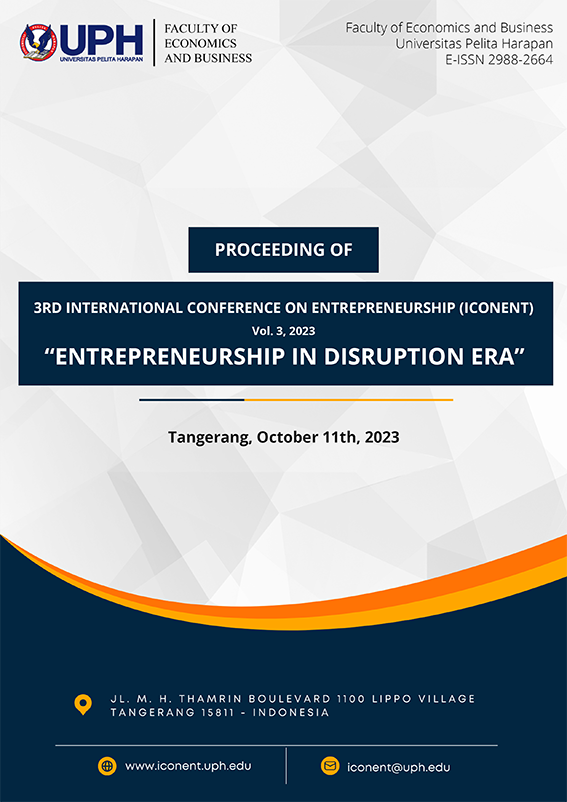The Effect of Financial Distress on Capital Structure in Indonesia Banking Sector
Keywords:
Leverage Ratio, Commercial BanksAbstract
Banking industry is believed as a vanguard of a country’s economy. If a bank experiences financial distress, not only that bank will face financial difficulties, but also have a systemic impact on all customers of that bank. So, capital structure of banking industry is a crucial thing. Capital structure in this study is proxied by Leverage Ratio. All of companies need leverage, but if leverage seems too high, it will have bad consequences for the company itself. Then, Banks, which are industry that really needs high liquidity also need leverage. Especially, when financial distress occurs, whether banks need to increase the proportion of their debt or not in order to survive. This research uses 23 commercial banks in Indonesia with quarterly panel data from 2012 to 2022. Results of this study state that Financial Distress can have a significant positive effect on increasing the Leverage Ratio of banks in Indonesia.
References
Altman, E. I. (1968a). Financial Ratios, Discriminant Analysis and the Prediction of Corporate Bankruptcy. The Journal of Finance, 23(4), 589. https://doi.org/10.2307/2978933
Alvin, F. (2015). Pengaruh Rasio Finansial dan Indikator Makroekonomik terhadap Financial Distress pada Perusahaan di Indonesia. Universitas Pelita Harapan.
Baker, M., & Wurgler, J. (2002). Market Timing and Capital Structure. The Journal of Finance, 7(1). Modeling Default Risk, (December 18, 2003).
Fama, E. F. (1970). Efficient Capital Markets: A Review of Theory and Empirical Work. Papers and Proceedings of the Twenty-Eighth Annual Meeting of the American Finance Association New York, N.Y. December, 25(2), 383-417.
Giovanni, A., Utami, D. W., & Yuzevin, T. (2020). Leverage dan Profitabilitas dalam Memprediksi Financial Distress Perusahaan Pertambangan Periode 2016-2018. 10(1).
Graham, B. (2009). The Intelligent Investor, Rev. Ed.
Masardi, D., Irwadi, M., & Tripermata, L. (2021). Pengaruh Rasio Keuangan dan Kondisi Financial Distress Terhadap Struktur Modal Pada Perusahaan Manufaktur Goldenblossom Sumatera (Gbs). Jurnal Ilmu Sosial, Manajemen, Akuntansi Dan Bisnis, 2(3), 44-54. https://doi.org/10.47747/jismab.v2i3.418
Nurkhasanah, D., & Nur, D. I. (2022). Analisis Struktur Modal pada Perusahaan Food And Beverage yang Terdaftar di Bursa Efek Indonesia. Universitas Pembangunan Nasional “Veteran” Jawa Timur, 16(1).
Ramadani, A. W., & Ratmono, D. (2023). FINANCIAL DISTRESS PREDICTION: THE ROLE OF FINANCIAL RATIO AND FIRM SIZE. Jurnal Riset Akuntansi Kontemporer, 15(1), 19-26. https://doi.org/10.23969/jrak.v15i1.6428
Roubini, N., Cavallo, M., & Kisselev, K. (2005). Exchange Rate Overshooting and The Costs of Floating.
Salim, M. N., & Firdaus, Z. (2020). Determinants of Firm Value And Its Impact On Stock Prices (Study in Consumer Good Public Companies in IDX 2014-2018).
Spence, M. (1973). Job Market Signaling. The Quarterly Journal of Economics, 87(3), 355. https://doi.org/10.2307/1882010

 Fakultas Ekonomi dan Bisnis | Universitas Pelita Harapan | Kampus Universitas Pelita Harapan | Gedung F Lt. 12 | Lippo Karawaci, Tangerang - 15811 | Telp 021-5460901 | Fax 54210992
Fakultas Ekonomi dan Bisnis | Universitas Pelita Harapan | Kampus Universitas Pelita Harapan | Gedung F Lt. 12 | Lippo Karawaci, Tangerang - 15811 | Telp 021-5460901 | Fax 54210992